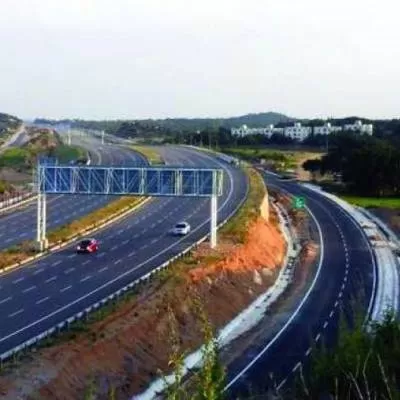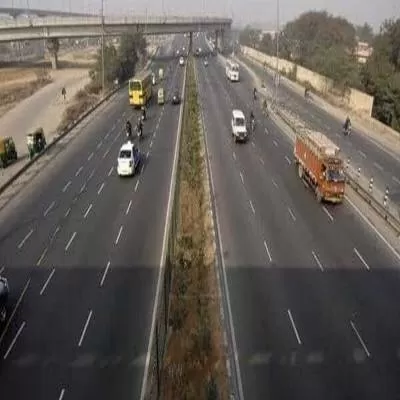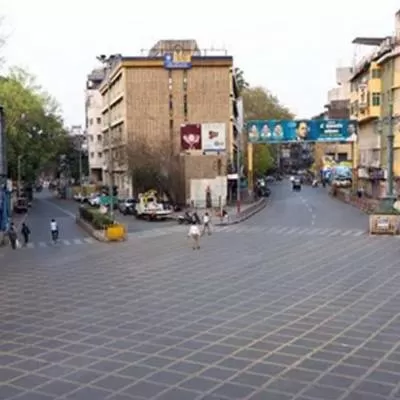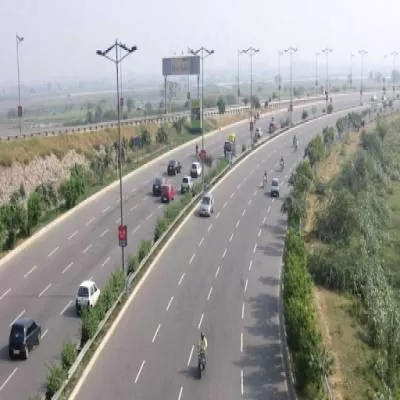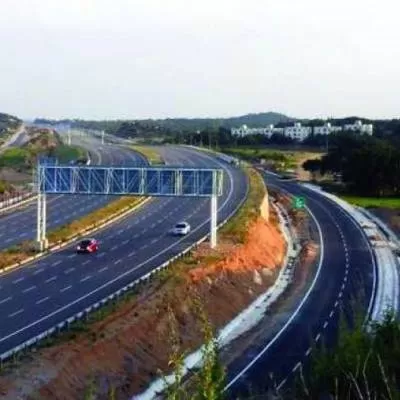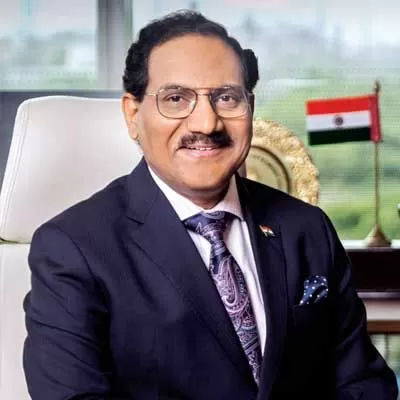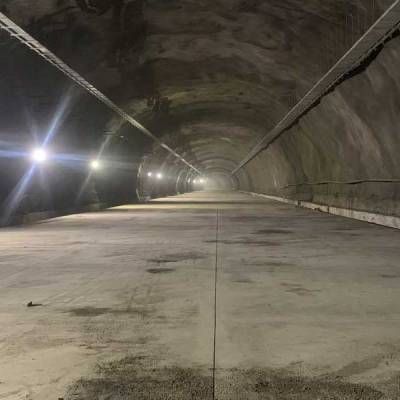- Home
- Infrastructure Transport
- ROADS & HIGHWAYS
- Target 8,800 km!
Target 8,800 km!
Infrastructure is the key to unlocking the true potential of India. That fact is unarguable. As M Murali, Director General, National Highways Builders Federation (NHBF), points out, “Although India currently has 3.3 million km of roads – the second largest such network in the world – the shortage of highways has been a major hurdle for attracting foreign investment.” That’s why, as allocations go, it doesn’t get bigger – or better – than this. The figure speaks for itself: 8,800 km of road projects to be awarded by the government in FY12-13. The highest ever in history. And, as the superlatives mount, analysts are crying themselves hoarse about this being the mother of all opportunities for the construction-infrastructure sector.
Plan of action
“Although there are 71,000 km of national highways, 16,000 are single-lane roads,” Murali tells us. “To embrace the challenge of building 20 km per day, the Government of India has embarked on one of the largest public-private partnership (PPP) schemes in history. The cost will amount to $20 billion, 60 per cent of which will be raised by the private sector.”
When asked about the finance plan, Dr Jagdeep Narayan Singh, Member (Finance), National Highways Authority of India (NHAI) says, there are three sources of finance: cess from the Government of India on every litre of petrol or diesel bought, which is expected to work out to approximately Rs 8,000-9,000 crore; toll collected on roads made by NHAI or premium on roads made by private developers; and money borrowed from the market. Does he prefer the BOT toll or annuity model? “BOT toll is a preferred method because there is no lingering of payment done,” he responds. “But, this method may not be possible in all stretches because there may not be traffic on all the roads. So, we have to go for either annuity or EPC.”
According to Murali, both BOT toll and annuity are suitable for the private sector. Meanwhile, N Seethaiah, Managing Director, Madhucon Projects Ltd, elaborates that in the BOT model, the project is funded by both equity and debt, with debt normally syndicated amongst four to five bankers. “NHAI has recently informed us that for 30 per cent of the total budgeted km for 2012-13, may opt for government funding,” he says. “In that case, at least 60 per cent of the 8,800 km is achievable. To get there, the state governments have to extend their full support to land acquisition and making available the necessary construction materials.” And, lauding the efforts being put in by NHAI and the government to make the 8,800 figure a reality, Kishore Avarsekar, Chairman & Managing Director, Unity Infraprojects Ltd, believes they will achieve the target.
Not surprisingly, Dr Singh is quick to point out the bonanza on offer, emphasising the fact that around 7,900 km have already been “done” in 2011. “We are on target to do 8,800,” he reiterates. “In terms of a strategy, we will step up what we have done already. Most of our feasibility reports (which include detailed geographical, topographical and cost analyses) have already been completed with the help of a large number of technical consultants, and the land acquisition process has been speeded up. Last year, we made e-tendering and annual prequalification mandatory, further speeding up the process.”
Past imperfect
While this sounds wonderful on paper, the problem has always lain not with the award of projects but their actual execution. “Last year too, NHAI had a set target of 7,300 km, which it achieved,” says B Seenaiah, Managing Director, BSCPL Infrastructure Ltd and President, National Highways Builders Federation. (see interview on page 96) “These were mainly BOT projects. Works have been awarded but are getting delayed on account of land acquisition. Once the project is awarded, it takes two months to sign, six months for financial closure, and after that, work begins.”
Samir Bansal, General Manager, India, Off-Highway Research India Pvt Ltd, echoes this sentiment, underlining that when the NHAI speaks of crossing its target last year, it is speaking of awards, not execution. “Work is yet to start on many projects,” he says. “Financial closure for many projects has not been done because of inflation, high interest rates and issues relating to land acquisition. They are going ahead with awards and hoping that the economic condition improves, interest rates start coming down and things start moving.”
Dr Singh, meanwhile, would like to draw our attention to the fact that it is a complicated process, or rather ‘processes’. “It is not one challenge,” he says. “There are three ongoing parallel processes. Once the feasibility report is prepared, the concessionaire has to obtain request for qualification (RFQ) and request for proposal (RFP), which is the bidding process. The second line is to take approvals at the government level, which includes the Cost Committee, the Planning Commission,
the Public Private Partnership Approval Committee headed by the secretary of the Department of Economic Affairs, and the secretaries of legal affairs and expenditure. Then, the Cabinet Committee must be approached for investments for any project over Rs 500 crore. The third part is land acquisition. We have to see that all three processes are in sync and things move
in tandem.”
The government’s good intentions are evident. Yet, the fact remains that there are a slew of roadblocks for entrepreneurs and contractors who take on NHAI projects. When asked to identify these, Murali’s extensive list, akin to a ready-reckoner, includes availability of land devoid of encumbrances; timely rehabilitation measures; removal or realignment of utilities and trees; permissions from the Forest Department, Ministry of Environment, Railways and the Mining Department; delay in decision or approval of design at various stages of execution; shortage of labour; cost escalation of labour and material; change in specifications; time and cost overruns; political risk; policy risk; withdrawal of financing; the unwillingness of people to pay toll; poor dispute resolution; and lack of coordination amongst various operators such as the employer, entrepreneur, consultant and financier.
Murali insists that to encourage the private sector to buy into the roads opportunity, some of these roadblocks must be corrected and contracts made more attractive. This includes working clauses within contracts with the input of private industry. One significant step, as he tells us, is recent reforms that will allow the government to shorten the length of time it takes to acquire land from 18 to eight months, with no project to be awarded until the government has already acquired 80 per cent of the land. Other heartening signs are a review of consultants who have consistently miscalculated cost estimates of projects and a more equitable process of dispute resolution that will avoid time-consuming arbitration battles.
Land, land, land
Still, it’s land acquisition that’s clearly on everyone’s mind – and lips. “Almost 90 per cent of NHAI projects are suffering from this,” emphasises Seenaiah.” The authority has improved in its processes, yet there is no effective interaction with the client. It negotiates and interacts with the state government to acquire land and assess value. Then, of the many sections under the National Highways Act, 1956, under Section 3G, the value of land should be assessed properly and accepted by NHAI accordingly. But, this takes almost one-and-a-half to two years, while in states like Bihar, West Bengal, Assam, it takes up to three to four years.”
In his view, although the NHAI’s target of 8,800 km is achievable if the model concession agreement is followed, it would be quite impossible that 80 per cent land would be given along with signing the contract, because there is no organisation for NHAI to acquire the land. “Although there are policies, major support is required from the state government,” he says. “We need continuous meetings between NHAI and the minister with the chief secretaries or ministries of all states. But, that is lacking.”
Seenaiah speaks from experience – he was working on a project awarded almost two years ago. It was tendered and the agreement signed; permission was granted to proceed with the work on November 21, 2011. “Even then, NHAI could have given 80 per cent of the land, but the process is still going on,” he rues. “The delays have been so grave. Once I complete the project, prices can be rigid. But, cost escalation is not borne by the department. NHAI must consider this.” He also bemoans that there is no system in place to monitor the progress of projects at the state level.
Take for instance the Rs 154.80-crore contract that BSCPL has been awarded for a highway on NHAI’s Chhattisgarh-Orissa border. “Our financial closure will happen in July-end 2012,” reveals Seenaiah. “There is almost 50 km of forest, and they do not want to give the commencement date unless they can give 80 per cent of the land. So, the tender was awarded almost eight months back, the agreement was signed in January, and I have to do my finances by July. To get over 80 per cent land, we are expecting a further delay of four to five months; hence, most likely, the project will move only in October-November 2012.”
When asked about any remedial measures in this regard, Dr Singh is not particularly forthcoming. “Land acquisition is done for us by the state government authorities and it is a routine thing,” he offers. “There cannot be any fundamental change in that; we are only ensuring that there is close monitoring at all levels.” Bansal seconds this, saying, “Land acquisition has to be done by state governments. NHAI is trying to take steps.”
Some states are trying to get it right. For instance, as Pratyaya Amrit, Managing Director, Bihar State Road Development Corporation, tells us, “Although our role in NHAI projects is only confined to land acquisition, it is very significant. In Bihar, at present, we do not have a single stretch where the tender is awaited for an NHDP Phase 3 project. This is noteworthy.” Amrit says that this owes to a unique strategy involving periodic consultations on various levels in order to ensure that every issue, whether large or small, is solved at the relevant level. Similarly, SM Ramchandani, Joint Managing Director, Maharashtra State Road Development Corporation, tells us that there are no issues with land acquisition in his state. “People are very cooperative,” he iterates.
Heartening signs to be sure. But, as Bansal himself is quick to add, “Things have not moved as probably everyone wants them to.”
Building solutions
True enough. And, builders and contractors have some solutions of their own to speed up the process of land acquisition and obtain the necessary clearances. For instance, other than adherence to the model concession agreement that calls for 80 per cent of land with the contract, Seenaiah believes that the cost of land should be assessed at what it would be two to three years after development and that farmers/landowners should be offered certain incentives, perhaps to the tune of Rs 1,000 crore, initially. “As far as I know, about Rs 55,000 crore of works have been completed, but there are claims that around Rs 10,000 crore of works or more are under arbitration. This is certainly due to land issues.”
For his part, Murali has drawn up a suggestive plan for mitigation of delays in highway projects, particularly owing to delays in procuring right of way and forest and environmental clearance. “Most BOT highways are delayed up to 36 months, and even beyond, due to delay in fulfilling obligations under the conditions precedent prescribed under Article 4 of the Concession Contract,” he explains. Here’s the rub: the award of projects is very quick, right after the opening of bids, and the concessionaire is asked to sign the agreement within 45 days – irrespective of delays in land acquisition and clearances! His plan, as articulated in the matrix (See Table: A), aims to clear the way for speedy implementation of projects.
Doing one’s bidding
Inspite of the many obstacles in the way of contractors, the thrill of the chase is definitely addictive. What, then, actually prompts them to bid for a particular project? “We consider availability of material, right of way, the location, number of structures and required internal rate of return (IRR),” Seethaiah responds promptly.
Avarsekar uses the example of a project to explain. “If I am talking about the Suratgad-Sriganganagar section, traffic is an important consideration,” he says. “Commercially, that road is very important for the development of that section of India, and it will give us good mileage; also, the IRR is good.”
One trend observed in 2010-11 was that of the 33 BOT toll projects awarded by NHAI till December 2011, 23 were premium bids. Murali attributes this to the increase in bidders from other infra sectors where opportunities were poor and anticipated increase in toll revenues. This begs the question whether the trend is here to stay. Dr Singh’s answer is succinct, “No.” He goes on to add, “We will also do a number of two-lane highways with less traffic so they may not get that type of premium.” He is equally forthright when asked about ‘aggressive bidding’ for highway projects. “I don’t think there is aggressive bidding,” he says. “Bidders bid according to their capability, and they have a fine judgement of what the tolling will be like. Other bidders may feel that is aggressive, but it is their perception.”
Here, Avarsekar has another take. “NHAI has come out with its own pattern of qualifying some eminent infrastructure companies: the first-line infrastructure company and then the second-line infrastructure company,” he says. “Looking ahead, small-scale construction companies will certainly have a few restrictions in bidding for large projects and that will definitely improve the prospects of large, organised companies.”
Seethaiah is also candid while assessing the pros and cons of aggressive bidding. “It forces the developer to go in for inflated projected toll revenue, which will have a negative impact on viability,” he insists. “The advantages are that the order book of the winning company will improve, and NHAI will benefit because of higher premium accrual. The disadvantages are that the bankers who fund these projects will land up in huge NPAs (non performing assets), which will in turn affect the sector in future by an increase in interest rates to cover these NPAs, and the objective to provide high quality roads will fail, because aggressive bidding will make projects unviable.”
Dr Singh, though, is quick to dismiss any talk of viability issues. “So far, there has been financial closure of even the so-called highest bids like the GMR bids of Kishangarh-Udaipur-Ahmedabad or the bid by IRP, and they are in quite a good shape,” he insists.
The quality imperative
The aspiration all round, of course, is that the roads built remain in equally good shape! As Dr Singh says, “When we award road projects, we are looking to the concessionaire to maintain the road at a level of quality for the next 20-25 years. If he makes poor roads, he will suffer as the maintenance cost will be extremely high.” Quality checks by NHAI include a field level check and certification by an independent engineer paid partially by the body and the concessionaire. “Finally, the public at large can also comment,’ adds Dr Singh. “We have already launched a forum on Facebook and other places where the public can comment on and complain about roads. We have maintained absolute transparency. All our contracts are on the website, and anybody can report to us.” He insists that our national highways are now comparable in quality to most parts of the globe.
Murali agrees that Indian roads are vastly improved; he attributes it to a sea change in construction and maintenance technology in the past few decades. Another important factor – this one more intangible – is the zeal of today’s quality contractors to get the job done well.
Take, for instance, Seethaiah, who tells us, “While executing a project, all efforts are taken in advance, right from the stage of bidding, to ensure it is executable within the time limit and any impediments ascertained. With regard to quality, we use all modern machinery as per NHAI specifications, and most are imported. Hence, providing quality is no problem. And, timely delivery is normally taken care of when right of way is given on time.”
For his part, Avarsekar has bagged two orders from NHAI; one for the Suratgar and Sriganganagar section of the Punjab-Sindh border worth Rs 330 crore, to be executed in 18 months, and the second on the Punjab-Haryana border worth
Rs 510 crore, to be built in 910 days. “For the second order, we have implemented certain technologies and have placed local people on site to ensure quality and tim-ely delivery.”
Indeed, as Murali says, with the increase in size and complexity of construction projects and growing shortage of skilled manpower, the need for better quality construction machinery and equipment has become more evident than ever before (see Table: A). “There is absolutely no doubt that mechanisation, after all these years, has at last succeeded in establishing a firm footing in the Indian roads sector,” he says. “Road maintenance though is yet to benefit from it. Equally important is the fact that the technologies being deployed by road developers in India lag way behind those in the global market and must be upgraded. Companies engaged in road development should have easy access to machinery like milling machines, recycling machines, auto grades, slurry sealing machine, ATF (accelerated testing facility) and ARAN (automatic road analyser). We must also manufacture low-cost machines for use in rural areas. Further, we need regular training for manpower using this machinery and equipment.”
As NHAI doesn’t make roads itself – as Dr Singh is quick to remind us – it remains “technology neutral,” allowing concessionaires to adopt any technology that is internationally or nationally accepted. Its primary concern, as he says, is not input parameters but output.
So will the output, promised on such a massive scale, live up to expectations? The government doesn’t see why not. “This is a tremendous opportunity for any developer or contractor,” urges Dr Singh. “He can bid as a BOT developer, or if not, he can be an EPC contractor for various developers. Also, there may be 2,000-3,000 km of roads that may not be too costly where he can bid directly. There are Rs 50,000-60,000 crore worth of contracts likely to happen in the next year; everyone can get a good chunk of the pie.”
The billion-dollar question is, will they bite given the various obstacles that have hamstrung projects in the past? Murali’s statement appears to answer that: “Hope-fully, the award for projects for FY12-13 will start from the second quarter of the financial year.” The road race goes on – with hopefully more pace, and less rage.
Equipped for the long road
To turn 8,800 from a mere number to actual kilometres on the ground will take a lot of commitment, hard work, will power – and, of course, equipment. Thus, not surprisingly, the Budget announcement has the equipment market abuzz. But, has that translated to actual sales? “As execution has not started on many of these projects, the market is still stable,” responds Samir Bansal, General Manager-India, Off-Highway Research India Pvt Ltd. “Going forward, we expect things to rectify. It is in the interest of all concessionaires to start PPP projects at the earliest, as the revenue too starts earlier.”
“The construction equipment market basically derives demand from activity,” says Rajesh Sharma, Executive Vice-President, Escorts Group. “If activity goes up, everything goes up.” For his part, Vipin Sondhi, Managing Director, JCB India Pvt Ltd, says, “There will not be an increase in demand in the short term as there is a gestation period owing to encumbrances like land acquisition and environment clearances. But, if we are to meet the target of 8,800 km for 2012-13, it will definitely result in an increase in demand in the long run.”
“The road construction equipment market currently stands at an industry volume of 2,500 machines per year and is growing at the rate of 5-10 per cent,” says AM Muralidharan, Managing Director, Volvo India Pvt Ltd. “The market is expected to grow at a similar rate for the next five years. In this segment, Volvo has a market share of 22 to 24 per cent.”
Hot movers
“Starting from excavators, compactors and motor graders, finishers, plants, crushers, hot mix and batching plants, there is a set of equipment that everyone is aware will be required,” says Bansal. “The demand for this will grow along with need for tonnes of reloaders and dozers.”
“The sales of compactors, which are specially meant for road construction, are directly proportional to activity in road sectors, whereas excavators and back-loaders find use in other areas too,” says Sharma. Other road-specific equipment includes compactors, motor graders and asphalt and concrete pavers.
“The use of high vibratory compaction equipment can directly contribute to timely completion of projects,” says Sondhi. “JCB’s backhoe loaders and tracked excavators are widely used in road projects during the preparatory stages. And, during road building, our vibratory soil compactor VM115 and vibratory tandem roller VMT860 are used.”
Volvo’s range of products for road construction includes pavers, asphalt compactors, soil compactors, and milling equipment
Buy or rent?
As Bansal explains, “The contractor’s option to buy, lease or rent depends on how the project is being executed, whether it is being subcontracted, the duration of requirement and so on. It will always be a mix of purchase and rental. Again, as per leasing, most equipment bought by retail customers is financed. But, if the project is getting financed, the equipment then gets covered under project finance.”
“Our country is one of the cheapest in the world in terms of basic ownership cost,” says Sharma. “Indian contractors are basically buying equipment from Indian manufacturers, so affordability is not a problem. Leasing and renting options are also vibrant.” But, in the roads segment, he says 70 per cent of the equipment required, like compactors, pavers and motor graders, is likely to be owned.
“India is a global hub for road construction equipment with many manufacturers like JCB manufacturing machines for Indian conditions,” points out Sondhi. “Contractors and hirers have a plethora of options at an affordable cost. Most buyers prefer buying, owing to the good rate of returns. These are generally entrepreneurs who then rent out machines.”
Meanwhile, Muralidharan says, “With nearly 80 per cent of all construction equipment sold in India being financed, financial intermediaries have played a key role in the growth of this sector. The financing industry is dominated by NBFCs in terms of market share. Volvo Financial Services, through its exclusive partnership with Srei BNP Paribas, is enabling financial assistance for construction equipment. Although the rent model is developed in the global market, in India it is still highly unorganised.”
And finally...
Meanwhile, Bansal is looking ahead with optimism. “We are bullish on demand,” he says. “Once the execution on these projects starts, there will be a big boost in the demand of all related equipments. Everyone is waiting.”
Schedule for compliance of obligations for implementation of BOT highways: From feasibility stage to appointed date
Before floating the enquiry/before issuance of the LoA
- Land acquisition to be completed
- NHAI to approve and deposit the amounts for shifting of utilities to the concerned departments and forest department for cutting of trees
- Reserved/private forest clearance including wildlife
- MoEF clearance for the project, including soil/rubble quarries
- MoU to be completed with railway authorities for RoBs.
- Shifting of utilities and tree cutting
- Appointment of independent engineer (IE)
- In absence of IE, approval of mix designs, design of pavements/structures/bridges, etc, nearby IIT/NIT to be nominated.
- If land acquisition has been completed, the concessionaire can perform the topographic survey, soil investigations, design of the roads/structures/major and minor bridges, RoBs
- During performance of the above activities, we can ascertain the ground situation from villagers/landowners for any obstructions/stopping of works.
- Concessionaire shall apply to various departments for permits/licences for installation of plants at site. NHAI’s full cooperation or follow-up with respective authorities to get the approvals in time
- Appointment of IE
- Finalisation of the change of scope works on a war footing
- Follow-up with the railway authorities for approval of RoBs design/construction activities.
- Land acquisition
- Utility shifting
- Tree cutting
- MoEF clearances
- Reserve/private forest clearances
- RoBs
- Appointment of IE
(With inputs from Shriyal Sethumadhavan, Shanti Padukone and Shubhangi Bidwe)
It’s the most ambitious road development plan in Indian history: almost 9,000 km of projects to be awarded in the year ahead, the task of building 20 km of roads a day, roads that benchmark the best in the world in terms of quality and safety. Can we deliver? CW presents problems, perspectives and possible solutions.Infrastructure is the key to unlocking the true potential of India. That fact is unarguable. As M Murali, Director General, National Highways Builders Federation (NHBF), points out, “Although India currently has 3.3 million km of roads – the second largest such network in the world – the shortage of highways has been a major hurdle for attracting foreign investment.” That’s why, as allocations go, it doesn’t get bigger – or better – than this. The figure speaks for itself: 8,800 km of road projects to be awarded by the government in FY12-13. The highest ever in history. And, as the superlatives mount, analysts are crying themselves hoarse about this being the mother of all opportunities for the construction-infrastructure sector.Plan of action“Although there are 71,000 km of national highways, 16,000 are single-lane roads,” Murali tells us. “To embrace the challenge of building 20 km per day, the Government of India has embarked on one of the largest public-private partnership (PPP) schemes in history. The cost will amount to $20 billion, 60 per cent of which will be raised by the private sector.”When asked about the finance plan, Dr Jagdeep Narayan Singh, Member (Finance), National Highways Authority of India (NHAI) says, there are three sources of finance: cess from the Government of India on every litre of petrol or diesel bought, which is expected to work out to approximately Rs 8,000-9,000 crore; toll collected on roads made by NHAI or premium on roads made by private developers; and money borrowed from the market. Does he prefer the BOT toll or annuity model? “BOT toll is a preferred method because there is no lingering of payment done,” he responds. “But, this method may not be possible in all stretches because there may not be traffic on all the roads. So, we have to go for either annuity or EPC.”According to Murali, both BOT toll and annuity are suitable for the private sector. Meanwhile, N Seethaiah, Managing Director, Madhucon Projects Ltd, elaborates that in the BOT model, the project is funded by both equity and debt, with debt normally syndicated amongst four to five bankers. “NHAI has recently informed us that for 30 per cent of the total budgeted km for 2012-13, may opt for government funding,” he says. “In that case, at least 60 per cent of the 8,800 km is achievable. To get there, the state governments have to extend their full support to land acquisition and making available the necessary construction materials.” And, lauding the efforts being put in by NHAI and the government to make the 8,800 figure a reality, Kishore Avarsekar, Chairman & Managing Director, Unity Infraprojects Ltd, believes they will achieve the target.Not surprisingly, Dr Singh is quick to point out the bonanza on offer, emphasising the fact that around 7,900 km have already been “done” in 2011. “We are on target to do 8,800,” he reiterates. “In terms of a strategy, we will step up what we have done already. Most of our feasibility reports (which include detailed geographical, topographical and cost analyses) have already been completed with the help of a large number of technical consultants, and the land acquisition process has been speeded up. Last year, we made e-tendering and annual prequalification mandatory, further speeding up the process.”Past imperfectWhile this sounds wonderful on paper, the problem has always lain not with the award of projects but their actual execution. “Last year too, NHAI had a set target of 7,300 km, which it achieved,” says B Seenaiah, Managing Director, BSCPL Infrastructure Ltd and President, National Highways Builders Federation. (see interview on page 96) “These were mainly BOT projects. Works have been awarded but are getting delayed on account of land acquisition. Once the project is awarded, it takes two months to sign, six months for financial closure, and after that, work begins.”Samir Bansal, General Manager, India, Off-Highway Research India Pvt Ltd, echoes this sentiment, underlining that when the NHAI speaks of crossing its target last year, it is speaking of awards, not execution. “Work is yet to start on many projects,” he says. “Financial closure for many projects has not been done because of inflation, high interest rates and issues relating to land acquisition. They are going ahead with awards and hoping that the economic condition improves, interest rates start coming down and things start moving.”Dr Singh, meanwhile, would like to draw our attention to the fact that it is a complicated process, or rather ‘processes’. “It is not one challenge,” he says. “There are three ongoing parallel processes. Once the feasibility report is prepared, the concessionaire has to obtain request for qualification (RFQ) and request for proposal (RFP), which is the bidding process. The second line is to take approvals at the government level, which includes the Cost Committee, the Planning Commission, the Public Private Partnership Approval Committee headed by the secretary of the Department of Economic Affairs, and the secretaries of legal affairs and expenditure. Then, the Cabinet Committee must be approached for investments for any project over Rs 500 crore. The third part is land acquisition. We have to see that all three processes are in sync and things move in tandem.”The government’s good intentions are evident. Yet, the fact remains that there are a slew of roadblocks for entrepreneurs and contractors who take on NHAI projects. When asked to identify these, Murali’s extensive list, akin to a ready-reckoner, includes availability of land devoid of encumbrances; timely rehabilitation measures; removal or realignment of utilities and trees; permissions from the Forest Department, Ministry of Environment, Railways and the Mining Department; delay in decision or approval of design at various stages of execution; shortage of labour; cost escalation of labour and material; change in specifications; time and cost overruns; political risk; policy risk; withdrawal of financing; the unwillingness of people to pay toll; poor dispute resolution; and lack of coordination amongst various operators such as the employer, entrepreneur, consultant and financier.Murali insists that to encourage the private sector to buy into the roads opportunity, some of these roadblocks must be corrected and contracts made more attractive. This includes working clauses within contracts with the input of private industry. One significant step, as he tells us, is recent reforms that will allow the government to shorten the length of time it takes to acquire land from 18 to eight months, with no project to be awarded until the government has already acquired 80 per cent of the land. Other heartening signs are a review of consultants who have consistently miscalculated cost estimates of projects and a more equitable process of dispute resolution that will avoid time-consuming arbitration battles.Land, land, landStill, it’s land acquisition that’s clearly on everyone’s mind – and lips. “Almost 90 per cent of NHAI projects are suffering from this,” emphasises Seenaiah.” The authority has improved in its processes, yet there is no effective interaction with the client. It negotiates and interacts with the state government to acquire land and assess value. Then, of the many sections under the National Highways Act, 1956, under Section 3G, the value of land should be assessed properly and accepted by NHAI accordingly. But, this takes almost one-and-a-half to two years, while in states like Bihar, West Bengal, Assam, it takes up to three to four years.”In his view, although the NHAI’s target of 8,800 km is achievable if the model concession agreement is followed, it would be quite impossible that 80 per cent land would be given along with signing the contract, because there is no organisation for NHAI to acquire the land. “Although there are policies, major support is required from the state government,” he says. “We need continuous meetings between NHAI and the minister with the chief secretaries or ministries of all states. But, that is lacking.”Seenaiah speaks from experience – he was working on a project awarded almost two years ago. It was tendered and the agreement signed; permission was granted to proceed with the work on November 21, 2011. “Even then, NHAI could have given 80 per cent of the land, but the process is still going on,” he rues. “The delays have been so grave. Once I complete the project, prices can be rigid. But, cost escalation is not borne by the department. NHAI must consider this.” He also bemoans that there is no system in place to monitor the progress of projects at the state level.Take for instance the Rs 154.80-crore contract that BSCPL has been awarded for a highway on NHAI’s Chhattisgarh-Orissa border. “Our financial closure will happen in July-end 2012,” reveals Seenaiah. “There is almost 50 km of forest, and they do not want to give the commencement date unless they can give 80 per cent of the land. So, the tender was awarded almost eight months back, the agreement was signed in January, and I have to do my finances by July. To get over 80 per cent land, we are expecting a further delay of four to five months; hence, most likely, the project will move only in October-November 2012.”When asked about any remedial measures in this regard, Dr Singh is not particularly forthcoming. “Land acquisition is done for us by the state government authorities and it is a routine thing,” he offers. “There cannot be any fundamental change in that; we are only ensuring that there is close monitoring at all levels.” Bansal seconds this, saying, “Land acquisition has to be done by state governments. NHAI is trying to take steps.”Some states are trying to get it right. For instance, as Pratyaya Amrit, Managing Director, Bihar State Road Development Corporation, tells us, “Although our role in NHAI projects is only confined to land acquisition, it is very significant. In Bihar, at present, we do not have a single stretch where the tender is awaited for an NHDP Phase 3 project. This is noteworthy.” Amrit says that this owes to a unique strategy involving periodic consultations on various levels in order to ensure that every issue, whether large or small, is solved at the relevant level. Similarly, SM Ramchandani, Joint Managing Director, Maharashtra State Road Development Corporation, tells us that there are no issues with land acquisition in his state. “People are very cooperative,” he iterates.Heartening signs to be sure. But, as Bansal himself is quick to add, “Things have not moved as probably everyone wants them to.”Building solutionsTrue enough. And, builders and contractors have some solutions of their own to speed up the process of land acquisition and obtain the necessary clearances. For instance, other than adherence to the model concession agreement that calls for 80 per cent of land with the contract, Seenaiah believes that the cost of land should be assessed at what it would be two to three years after development and that farmers/landowners should be offered certain incentives, perhaps to the tune of Rs 1,000 crore, initially. “As far as I know, about Rs 55,000 crore of works have been completed, but there are claims that around Rs 10,000 crore of works or more are under arbitration. This is certainly due to land issues.”For his part, Murali has drawn up a suggestive plan for mitigation of delays in highway projects, particularly owing to delays in procuring right of way and forest and environmental clearance. “Most BOT highways are delayed up to 36 months, and even beyond, due to delay in fulfilling obligations under the conditions precedent prescribed under Article 4 of the Concession Contract,” he explains. Here’s the rub: the award of projects is very quick, right after the opening of bids, and the concessionaire is asked to sign the agreement within 45 days – irrespective of delays in land acquisition and clearances! His plan, as articulated in the matrix (See Table: A), aims to clear the way for speedy implementation of projects.Doing one’s biddingInspite of the many obstacles in the way of contractors, the thrill of the chase is definitely addictive. What, then, actually prompts them to bid for a particular project? “We consider availability of material, right of way, the location, number of structures and required internal rate of return (IRR),” Seethaiah responds promptly.Avarsekar uses the example of a project to explain. “If I am talking about the Suratgad-Sriganganagar section, traffic is an important consideration,” he says. “Commercially, that road is very important for the development of that section of India, and it will give us good mileage; also, the IRR is good.”One trend observed in 2010-11 was that of the 33 BOT toll projects awarded by NHAI till December 2011, 23 were premium bids. Murali attributes this to the increase in bidders from other infra sectors where opportunities were poor and anticipated increase in toll revenues. This begs the question whether the trend is here to stay. Dr Singh’s answer is succinct, “No.” He goes on to add, “We will also do a number of two-lane highways with less traffic so they may not get that type of premium.” He is equally forthright when asked about ‘aggressive bidding’ for highway projects. “I don’t think there is aggressive bidding,” he says. “Bidders bid according to their capability, and they have a fine judgement of what the tolling will be like. Other bidders may feel that is aggressive, but it is their perception.”Here, Avarsekar has another take. “NHAI has come out with its own pattern of qualifying some eminent infrastructure companies: the first-line infrastructure company and then the second-line infrastructure company,” he says. “Looking ahead, small-scale construction companies will certainly have a few restrictions in bidding for large projects and that will definitely improve the prospects of large, organised companies.”Seethaiah is also candid while assessing the pros and cons of aggressive bidding. “It forces the developer to go in for inflated projected toll revenue, which will have a negative impact on viability,” he insists. “The advantages are that the order book of the winning company will improve, and NHAI will benefit because of higher premium accrual. The disadvantages are that the bankers who fund these projects will land up in huge NPAs (non performing assets), which will in turn affect the sector in future by an increase in interest rates to cover these NPAs, and the objective to provide high quality roads will fail, because aggressive bidding will make projects unviable.”Dr Singh, though, is quick to dismiss any talk of viability issues. “So far, there has been financial closure of even the so-called highest bids like the GMR bids of Kishangarh-Udaipur-Ahmedabad or the bid by IRP, and they are in quite a good shape,” he insists.The quality imperativeThe aspiration all round, of course, is that the roads built remain in equally good shape! As Dr Singh says, “When we award road projects, we are looking to the concessionaire to maintain the road at a level of quality for the next 20-25 years. If he makes poor roads, he will suffer as the maintenance cost will be extremely high.” Quality checks by NHAI include a field level check and certification by an independent engineer paid partially by the body and the concessionaire. “Finally, the public at large can also comment,’ adds Dr Singh. “We have already launched a forum on Facebook and other places where the public can comment on and complain about roads. We have maintained absolute transparency. All our contracts are on the website, and anybody can report to us.” He insists that our national highways are now comparable in quality to most parts of the globe. Murali agrees that Indian roads are vastly improved; he attributes it to a sea change in construction and maintenance technology in the past few decades. Another important factor – this one more intangible – is the zeal of today’s quality contractors to get the job done well.Take, for instance, Seethaiah, who tells us, “While executing a project, all efforts are taken in advance, right from the stage of bidding, to ensure it is executable within the time limit and any impediments ascertained. With regard to quality, we use all modern machinery as per NHAI specifications, and most are imported. Hence, providing quality is no problem. And, timely delivery is normally taken care of when right of way is given on time.”For his part, Avarsekar has bagged two orders from NHAI; one for the Suratgar and Sriganganagar section of the Punjab-Sindh border worth Rs 330 crore, to be executed in 18 months, and the second on the Punjab-Haryana border worth Rs 510 crore, to be built in 910 days. “For the second order, we have implemented certain technologies and have placed local people on site to ensure quality and tim-ely delivery.”Indeed, as Murali says, with the increase in size and complexity of construction projects and growing shortage of skilled manpower, the need for better quality construction machinery and equipment has become more evident than ever before (see Table: A). “There is absolutely no doubt that mechanisation, after all these years, has at last succeeded in establishing a firm footing in the Indian roads sector,” he says. “Road maintenance though is yet to benefit from it. Equally important is the fact that the technologies being deployed by road developers in India lag way behind those in the global market and must be upgraded. Companies engaged in road development should have easy access to machinery like milling machines, recycling machines, auto grades, slurry sealing machine, ATF (accelerated testing facility) and ARAN (automatic road analyser). We must also manufacture low-cost machines for use in rural areas. Further, we need regular training for manpower using this machinery and equipment.”As NHAI doesn’t make roads itself – as Dr Singh is quick to remind us – it remains “technology neutral,” allowing concessionaires to adopt any technology that is internationally or nationally accepted. Its primary concern, as he says, is not input parameters but output.So will the output, promised on such a massive scale, live up to expectations? The government doesn’t see why not. “This is a tremendous opportunity for any developer or contractor,” urges Dr Singh. “He can bid as a BOT developer, or if not, he can be an EPC contractor for various developers. Also, there may be 2,000-3,000 km of roads that may not be too costly where he can bid directly. There are Rs 50,000-60,000 crore worth of contracts likely to happen in the next year; everyone can get a good chunk of the pie.”The billion-dollar question is, will they bite given the various obstacles that have hamstrung projects in the past? Murali’s statement appears to answer that: “Hope-fully, the award for projects for FY12-13 will start from the second quarter of the financial year.” The road race goes on – with hopefully more pace, and less rage.Equipped for the long roadTo turn 8,800 from a mere number to actual kilometres on the ground will take a lot of commitment, hard work, will power – and, of course, equipment. Thus, not surprisingly, the Budget announcement has the equipment market abuzz. But, has that translated to actual sales? “As execution has not started on many of these projects, the market is still stable,” responds Samir Bansal, General Manager-India, Off-Highway Research India Pvt Ltd. “Going forward, we expect things to rectify. It is in the interest of all concessionaires to start PPP projects at the earliest, as the revenue too starts earlier.”“The construction equipment market basically derives demand from activity,” says Rajesh Sharma, Executive Vice-President, Escorts Group. “If activity goes up, everything goes up.” For his part, Vipin Sondhi, Managing Director, JCB India Pvt Ltd, says, “There will not be an increase in demand in the short term as there is a gestation period owing to encumbrances like land acquisition and environment clearances. But, if we are to meet the target of 8,800 km for 2012-13, it will definitely result in an increase in demand in the long run.”“The road construction equipment market currently stands at an industry volume of 2,500 machines per year and is growing at the rate of 5-10 per cent,” says AM Muralidharan, Managing Director, Volvo India Pvt Ltd. “The market is expected to grow at a similar rate for the next five years. In this segment, Volvo has a market share of 22 to 24 per cent.”Hot movers“Starting from excavators, compactors and motor graders, finishers, plants, crushers, hot mix and batching plants, there is a set of equipment that everyone is aware will be required,” says Bansal. “The demand for this will grow along with need for tonnes of reloaders and dozers.”“The sales of compactors, which are specially meant for road construction, are directly proportional to activity in road sectors, whereas excavators and back-loaders find use in other areas too,” says Sharma. Other road-specific equipment includes compactors, motor graders and asphalt and concrete pavers.“The use of high vibratory compaction equipment can directly contribute to timely completion of projects,” says Sondhi. “JCB’s backhoe loaders and tracked excavators are widely used in road projects during the preparatory stages. And, during road building, our vibratory soil compactor VM115 and vibratory tandem roller VMT860 are used.”Volvo’s range of products for road construction includes pavers, asphalt compactors, soil compactors, and milling equipment Buy or rent?As Bansal explains, “The contractor’s option to buy, lease or rent depends on how the project is being executed, whether it is being subcontracted, the duration of requirement and so on. It will always be a mix of purchase and rental. Again, as per leasing, most equipment bought by retail customers is financed. But, if the project is getting financed, the equipment then gets covered under project finance.”“Our country is one of the cheapest in the world in terms of basic ownership cost,” says Sharma. “Indian contractors are basically buying equipment from Indian manufacturers, so affordability is not a problem. Leasing and renting options are also vibrant.” But, in the roads segment, he says 70 per cent of the equipment required, like compactors, pavers and motor graders, is likely to be owned.“India is a global hub for road construction equipment with many manufacturers like JCB manufacturing machines for Indian conditions,” points out Sondhi. “Contractors and hirers have a plethora of options at an affordable cost. Most buyers prefer buying, owing to the good rate of returns. These are generally entrepreneurs who then rent out machines.”Meanwhile, Muralidharan says, “With nearly 80 per cent of all construction equipment sold in India being financed, financial intermediaries have played a key role in the growth of this sector. The financing industry is dominated by NBFCs in terms of market share. Volvo Financial Services, through its exclusive partnership with Srei BNP Paribas, is enabling financial assistance for construction equipment. Although the rent model is developed in the global market, in India it is still highly unorganised.”And finally...Meanwhile, Bansal is looking ahead with optimism. “We are bullish on demand,” he says. “Once the execution on these projects starts, there will be a big boost in the demand of all related equipments. Everyone is waiting.”Schedule for compliance of obligations for implementation of BOT highways: From feasibility stage to appointed dateBefore floating the enquiry/before issuance of the LoALand acquisition to be completedNHAI to approve and deposit the amounts for shifting of utilities to the concerned departments and forest department for cutting of treesReserved/private forest clearance including wildlifeMoEF clearance for the project, including soil/rubble quarriesMoU to be completed with railway authorities for RoBs.The following can be done in between the concession agreement and appointed date:Shifting of utilities and tree cuttingAppointment of independent engineer (IE)In absence of IE, approval of mix designs, design of pavements/structures/bridges, etc, nearby IIT/NIT to be nominated.If land acquisition has been completed, the concessionaire can perform the topographic survey, soil investigations, design of the roads/structures/major and minor bridges, RoBsDuring performance of the above activities, we can ascertain the ground situation from villagers/landowners for any obstructions/stopping of works.Concessionaire shall apply to various departments for permits/licences for installation of plants at site. NHAI’s full cooperation or follow-up with respective authorities to get the approvals in timeAdministration of the concession agreement:Appointment of IEFinalisation of the change of scope works on a war footing Follow-up with the railway authorities for approval of RoBs design/construction activities.(Or) Incorporation of separate/individual milestones for the following activities under the concession agreement:Land acquisitionUtility shiftingTree cuttingMoEF clearancesReserve/private forest clearancesRoBsAppointment of IE(With inputs from Shriyal Sethumadhavan, Shanti Padukone and Shubhangi Bidwe)


